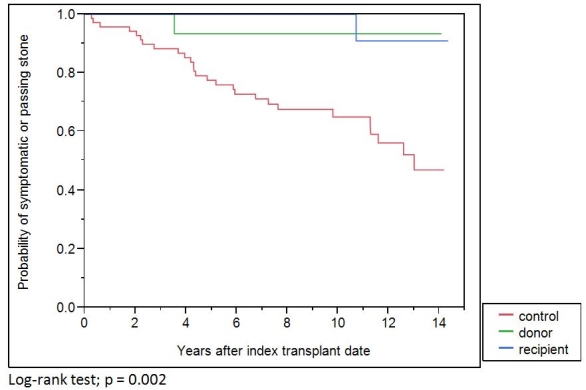Clinical Outcomes of Living Kidney Donors With Medullary Sponge Kidney
Nephrology and Hypertension, Mayo Clinic, Rochester, MN.
Meeting: 2015 American Transplant Congress
Abstract number: B184
Keywords: Donation, Kidney, Kidney transplantation, Outcome
Session Information
Session Name: Poster Session B: Living Donor Issues 1
Session Type: Poster Session
Date: Sunday, May 3, 2015
Session Time: 5:30pm-6:30pm
 Presentation Time: 5:30pm-6:30pm
Presentation Time: 5:30pm-6:30pm
Location: Exhibit Hall E
Background: Patients with medullary sponge kidney (MSK) commonly encounter recurrent nephrolithiasis. The objective of this study was to assess the clinical and safety outcomes of living kidney donors with MSK.
Methods: This was a single center, retrospectively cohort study conducted at a tertiary referral hospital. All adults with MSK who underwent nephrectomy as living kidney donors between January 2000 and December 2012 were included for this study. Non-donors with MSK were randomly selected by matching the year of birth and comorbidity score of the study cohort with a ratio of 1:3 for comparison.
Results: A total of 26 living kidney donors with MSK and 78 non-donors with MSK were eligible for the study. The incident rates of symptomatic stone were 0.7, 0.4 and 4.9 events/100 patient-years in donors, recipients and non-donors, respectively. After adjusting for history of kidney stone prior to index transplant date and baseline estimated glomerular filtration rate (eGFR), the kidney stone-related event was significantly lower in donors than in non-donors (HR 0.14; 95% CI 0.01–0.66). There was no significant difference in baseline eGFR in both donor and non-donor groups prior to index transplant date (79±22 vs 80±14 mL/min/1.73 m2; p = 0.37). At 5 years after index transplant date, there was no significant difference in eGFR between donors and non-donors (76.1 vs 70.9 mL/min/1.73 m2, p=0.12). None of the donors required dialysis at median follow-up time of 8.6 years (IQR 0.8-9.8 years). One non-donor developed end stage renal disease (ESRD) requiring dialysis at median follow-up time of 8.9 years (IQR 5.7-12.4 years). No donors died at median follow-up time of 12.7 years (IQR 8.6-13.9 years). Three non-donors died at median follow-up time of 12.6 years (IQR 8.6-13.6 years). 
Conclusions: After donation, kidney stone-related events are reduced in donors with MSK. The risks of renal function decline, ESRD, and mortality are not significantly increased after donation. These findings are reassuring for the safety of MSK kidney donors with normal kidney function and no significant comorbidity.
To cite this abstract in AMA style:
Cheungpasitporn W, Thongprayoon C, Brabec B, Kittanamongkolchai W, Erickson S. Clinical Outcomes of Living Kidney Donors With Medullary Sponge Kidney [abstract]. Am J Transplant. 2015; 15 (suppl 3). https://atcmeetingabstracts.com/abstract/clinical-outcomes-of-living-kidney-donors-with-medullary-sponge-kidney/. Accessed January 8, 2026.« Back to 2015 American Transplant Congress
